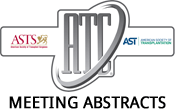2019 American Transplant Congress
Center-Level Variation in HLA-Incompatible Living Donor Kidney Transplantation Outcomes
1Johns Hopkins University, Baltimore, MD, 2University of Alabama School of Medicine, Birmingham, AL
*Purpose: Desensitization protocols for HLA-incompatible living donor kidney transplantation (ILDKT) vary across centers. The impact of these variations, as well as other practice variations, on…2019 American Transplant Congress
SIRPα Typing as a Potential Tool for Risk Stratification in Kidney Transplantation
Transplant Immunology Laboratory, Northwestern University, Chicago, IL
*Purpose: To determine if mismatches in the SIRPα receptor, associated with initiate innate alloresponses in animal models, may impact human kidney transplantation outcome.*Methods: To avoid…2019 American Transplant Congress
Characterization of Intra-Exosomal Cargoes of Circulating Donor Heart Specific Exosomes in Murine Heart Transplantation Model
Department of Surgery, University of Pennsylvania, Philadelphia, PA
*Purpose: Exosomes are tissue specific, bilayered, membrane-bound nanoparticles released by many types of cells into bodily fluids including blood and urine. Exosomes carry protein and…2019 American Transplant Congress
A2 To B Kidney Transplants Under Kidney Allocation System: A Prospective Study Of Anti A Titers And Correlation With Outcomes
Vanderbilt University, Nashville, TN
*Purpose: The UNOS KAS system incorporates A2 to B deceased donor kidney transplants (DDKTx) to improve access and reduce disparities in wait times for B…2019 American Transplant Congress
Unifying Interpretation of Molecular HLA Typing Data between the Solid Organ Allocation Match Run and Virtual Crossmatch
*Purpose: Virtual crossmatch compares a transplant candidate’s HLA antibody assay results to the HLA typing of the donor before an organ offer is accepted. While…2019 American Transplant Congress
Characterization of Circulating T-cell Specific Exosomes during Acute Rejection in Murine Heart Transplantation Model
*Purpose: Exosomes are nanoparticles (30-200nm) released by many cell types. They carry nucleic acid and proteins that may reflect conditional changes in their tissue counterparts.…2019 American Transplant Congress
Donor-Recipient HLA Mismatched Peptides Calculated by PIRCHE Algorithm Associate with De Novo Donor-Specific Cellular and Humoral Alloreactivity and Predicts Inferior Graft Outcome
*Purpose: PIRCHE-II algorithm predicts mismatched donor-derived HLA peptides number presented on recipient HLAclass-II molecules to recipient T-cells (indirect pathway of allorecognition) and has been associated…2019 American Transplant Congress
“Desens Light”: Single Center Experience Using Rituximab for High Immunologic Risk Kidney Transplant Recipients with Historic DSA
Comprehensive Transplant Center, Northwestern Memorial Hospital, Chicago, IL
*Purpose: To evaluate the effectiveness of rituximab as induction therapy for pts undergoing kidney transplant (Tx) with historic DSA (hDSA) [Desens. Light].*Methods: 104 consecutive pts…2019 American Transplant Congress
Patients with Immunological Diseases or on Peritoneal Dialysis Are Prone to False Positive Flow Cytometry Cross Match
*Purpose: Despite implementation of virtual cross matches, flow cytometry cross matches (FCXM) are still used by many transplant centers to determine immunological risk prior to…2018 American Transplant Congress
The Brazilian Epitope Virtual Crossmatch Protocol: A Reliable Tool for Increasing Kidney Allocation among Highly Sensitized Patients
Background: In Brazil (BZ), the kidney allocation policy for highly sensitized patients (HS) (PRA ≥ 80%) does not involve prioritization and transplants 10 times less…
- « Previous Page
- 1
- …
- 3
- 4
- 5
- 6
- 7
- …
- 9
- Next Page »
